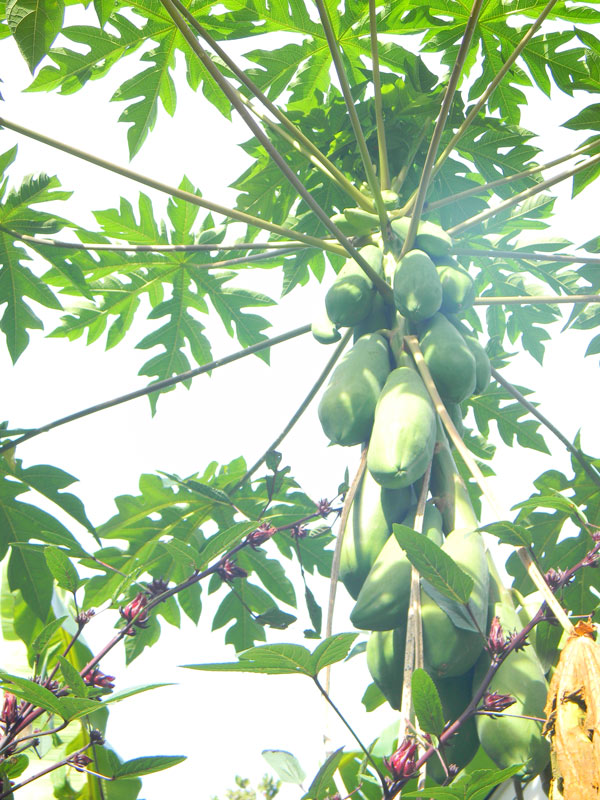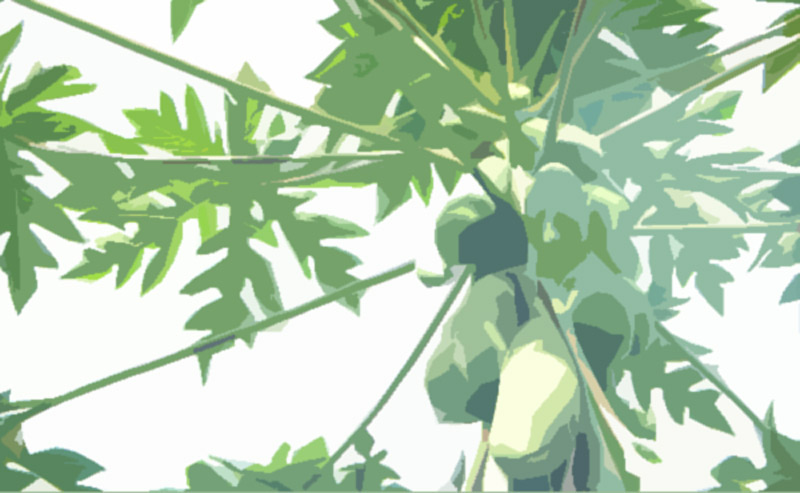On my post about growing papaya in North Florida, Peggy shares some accidental success on growing papaya from seed:
“Thank you for your article! I live in 9b (Citrus Springs) and never thought of growing papayas. We were in the grocery department of WalMart one day and they had these beautiful papayas that I couldn’t resist getting one. We ate and loved it, I even put some in the freezer for morning smoothies. The skin and seeds I put in my compost tub, not thinking anything of it. Months later, to my surprise, there were a BUNCH of plants growing out of the compost! By the time they were a foot tall, I realized I had a lot of papaya trees! I transplanted them again and again into pots. Not all especially the tiny ones transplanted well, but I ended up with more plants than I remember having seeds 🙂 . Now they range between 2′ and 5′ tall. We took them inside a shed for the horrible weather this winter for 2 weeks. I’m so happy to see the success you’ve had with them!”
I’ve had the best success with accidental compost pile fruit trees.
I’ve considered just throwing a bunch of compost and seeds into a bed on purpose, and keeping what grows out of it.
We’ve let pumpkins grow from the compost pile a bunch of times. This can be a problem, however, as now I usually save seeds from good pumpkins and get rid of seeds from poor specimens. This is important as we create a pumpkin landrace, since the inferior plants will pollinate the superior vines in my garden.
I have to remember not to let them grow anymore, but it’s hard to pull pretty pumpkin vines.
As for papaya, we used to grow a lot of them. They’re a plant I miss. It’s not easy to make them live in Alabama, but in the tropics they were a wonderful and productive garden favorite.
We grew them in North Florida, too, as I wrote in the post Peggy was commenting on. It was really fun seeing big, graceful papayas along the back of the house.

We could see them out our bedroom window. We didn’t get a lot of ripe fruit, but we had plenty of green ones for Thai papaya salad.


6 comments
I bet you end up with a big ole green house with a compost pile and barrels of water inside it heating it. I’ve had a makeshift one before and it was nice to have. I have a small one now with huge temp swings, unusable in the summer so far. I bet one that can be opened up or have shade cloth added would be useful to keep alive your love for the tropicals you are accustomed to. I think for myself in this climate, I’ll go with the flow. I need to start seeds earlier than I did last year. (Tomatoes, bell pepper) Getting the tomatoes in the ground at the proper soil temp and before it got too hot was a challenge this past year. Changes in attitude, changes in latitude, nothing remains quite the same.
Yes, it’s tempting. I’ve thought a lot about it, but haven’t pulled the trigger. Still digesting the house purchase.
We also need to get on top of getting transplants ready in time.
“I’ve considered just throwing a bunch of compost and seeds into a bed on purpose, and keeping what grows out of it.”
In my experience, I get pumpkins, tomatoes, grape seedlings, and Jerusalem artichokes. Since I use the compost heap mostly to fertilize my corn patch I just let the tomatoes and squash live on as an understory to suppress the weeds under the corn. I don’t know if it actually works like that, but it is an excuse to not hoe the corn once it gets shoulder high and the vines start sprawling below.
Right! “I’m not hoeing because the pumpkins said I didn’t have to.”
>I’ve considered just throwing a bunch of compost and seeds into a bed on purpose, and keeping what grows out of it.
You can do the same thing with a heavy mulch over good soil. To infuriate the people who think that you have to plant only clean seeds from a seed company, take fresh, wet seeds from a ripe (or even rotten) fruit, put in a bucket of grey water, and pour it out on a mulched area. This works!
A grow light helps during January/February chill times for especially pepper starts.
Comments are closed.